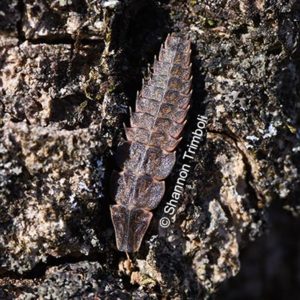After a crazy February and early March, spring has finally sprung! The red maples and elms bloomed at the beginning of the month. Now, the spicebushes are in full bloom and the early spring ephemeral wildflowers are starting to dot the woods. Not to mention the spring peepers are calling and I heard my first American toads just the other day. This is the time of year when everything is starting to change rapidly, and the changes are just going to get faster over the next few weeks. Below are a few of my nature-related discoveries and observations during the month of March.

Until I talked with Lynn Faust, the Firefly Lady, for my Backyard Ecology podcast, I always thought that you had to wait until the lightning bugs started flashing in the spring before you could find them. BUT, I was wrong. Lynn told me about the spring tree top flasher firefly (Pyractomena borealis). The larva, or baby fireflies, of this species crawl up onto the sides of tulip poplars, oaks, and hickories as the weather starts to warm up into the mid-50s and lower 60s.
Well, of course that meant I had to go firefly hunting on some of the warmer days this month. This is only one of several baby fireflies that I found on our property. If you want to hear more of my conversation with Lynn, you can do so in the episodes Lightning Bugs and Fireflies: A Conversation with Lynn Faust part 1 and part 2.

Somewhat warm, rainy days can be the perfect turn-on for snails. My husband found these earlier this month and came to get me because he knew I would want to see too. Yep, they are mating. The first picture is shortly after I arrived and they are very much in the middle of things. Our land snails are hermaphroditic and the big whitish colored thing in the middle is part of the male reproductive organs for the snail on the left. (The bluish or greyish cast to the reproductive organ is because of the lighting. In real life, it was white.)
The second picture is a few minutes later as they were wrapping things up. Yes, the reproductive opening on snails is on the side of the neck!! I had always assumed that it would be more in the neighborhood of the backside of the foot. I was surprised when I saw it going back into the neck, and had to look up what was happening.

Dan Dourson identified the mating snails as whitelip globe snails (Mesodon thyroidus). He says it is the most common species of snail in Kentucky. If you missed my conversation with Dan and Judy Dourson about land snails, then I encourage you to check it out. Trust me, it is hilarious! They make land snails interesting and fun to learn about.
In my Feb 2, 2021 article about January’s nature-related discoveries, I shared a picture of goldenrod galls in our fields and one that I had cut open so you could see the larva inside. While walking in our fields recently, I found a goldenrod gall that had been predated upon by a hungry bird. The bird had pecked a hole pecked in the side of the gall and pulled the larva out.

So, what interesting nature-related discoveries have you made in your yard and community over the last few weeks? I always enjoy hearing what others are finding too.

Backyard Ecology: Exploring Nature in Your Backyard
Nature isn’t just “out there.” It’s all around us, including right outside our doors. Hi, my name is Shannon Trimboli, and I am the host of Backyard Ecology. I live in southcentral Kentucky and am a wildlife biologist, educator, author, beekeeper, and owner of a nursery specializing in plants for pollinators and wildlife conservation. I invite you to join me as we ignite our curiosity and natural wonder, explore our yards and communities, and improve our local pollinator and wildlife habitat. Learn more or subscribe to my email list at www.backyardecology.net.

Leave a Reply